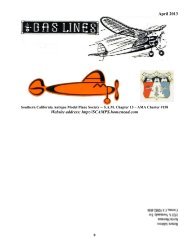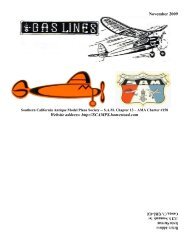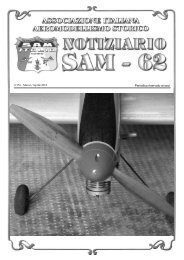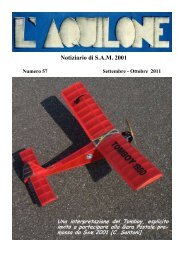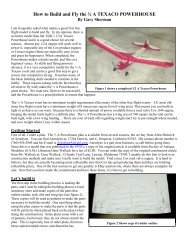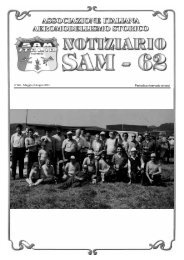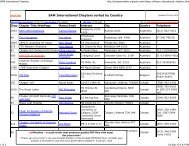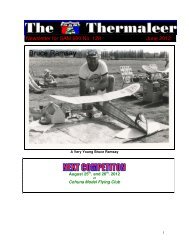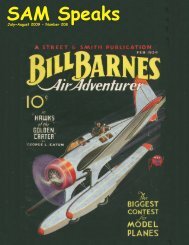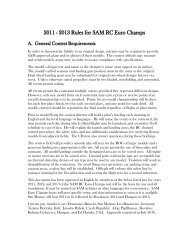Southern California Antique Model Plane Society – Sam 13
Southern California Antique Model Plane Society – Sam 13
Southern California Antique Model Plane Society – Sam 13
You also want an ePaper? Increase the reach of your titles
YUMPU automatically turns print PDFs into web optimized ePapers that Google loves.
this turbulent flow-so is there anything that can be done to help? Probably, and that is what Dick and his<br />
funny wing tip design are trying to determine in an elegant way. For an immediate solution to improve the<br />
Boomer wing (or any wing really) the fix is to have the trailing edge longer than the leading edge of the wing.<br />
The stock Boomer wing is already sorta like that, but Dick suggested around 40 degrees of rake in the tip to<br />
really exploit the characteristic.<br />
Okay-thanks! I developed a quick Boomer wing tip mod for 40 degrees, sawed off an existing wing and<br />
added a new tip to test this theory. Next weekend at the dog park I resumed rotor testing the modified wing,<br />
starting with the same location the turbulent flow was detected on the stock configuration. No observable<br />
movement of the rotor at this location-interest began to grow. Dick and I moved the rotor outboard in ¼ inch<br />
increments to within probably ½ inch from the<br />
pointy tip, still no movement. Now the master<br />
himself began questioning the validity of the process<br />
so I placed the rotor at the very end of the pointy<br />
wing tip and gave another short flight. Lo and<br />
behold, it was spinning-the very pointy tip was<br />
where the vortices was forming-exactly where you<br />
want it and likely very small too. BINGO-nailed it<br />
for a 40 degree raked tip. Is that much really<br />
required? I don’t know, but it was fun to see the<br />
problem so well solved with this simple<br />
configuration, which removed a considerable chunk<br />
of structure from the wing tip panel. Full power<br />
flight testing followed with lift developing in the<br />
area-it was impossible to detect any difference in<br />
performance between this wing and a stock one<br />
flown on the same fuselage by altering between<br />
flights.<br />
To further understand any performance changes, I waited until one very calm evening at dusk and went to the<br />
park near my house with both wings and one fuselage setup with a motor, etc. I weighed both wing<br />
configurations and ballasted the airplane for the wing weight difference for glide tests. From a small hill I<br />
glided each wing six times, alternating wings between flights for a total of 12 flights. It was still hard to<br />
visually detect any obvious performance advantage, but when comparing the time data the modified wing<br />
appeared to offer a 2.5% glide performance improvement over the stock wing. That’s not really a lot to<br />
thump your chest about, but it was a measurable difference which surprised me.<br />
So to get back to the earlier part of this column about having a heavy Boomer on your hands-you can save<br />
about .9 grams of weight by raking the wing tips 40 degrees. This is a weight savings that also translates into<br />
a performance gain not only in lighter weight for climb and sustained flight, but improved glide ratio from<br />
reduced wing tip drag. That folks is a WIN-WIN situation and why you should come to the dog park for aero<br />
engineer training from the master-Dick Baxter!<br />
August SCAMPS Club Contest<br />
by Gary Sherman<br />
After having a very mild summer so far, our August contest was held on what seemed like a hot day. It was<br />
well under 100 degrees but standing out in a field and flying always makes the temperature seem more<br />
extreme, and most flyers were packed up and leaving when the contest ended at 11:00 am. Even though it<br />
was a warm day, there seemed to be some pretty good lift and especially buoyant air early in the morning.<br />
After about 9:30, the air became spotty, but those who were doing a good job of picking air still did well.<br />
4



